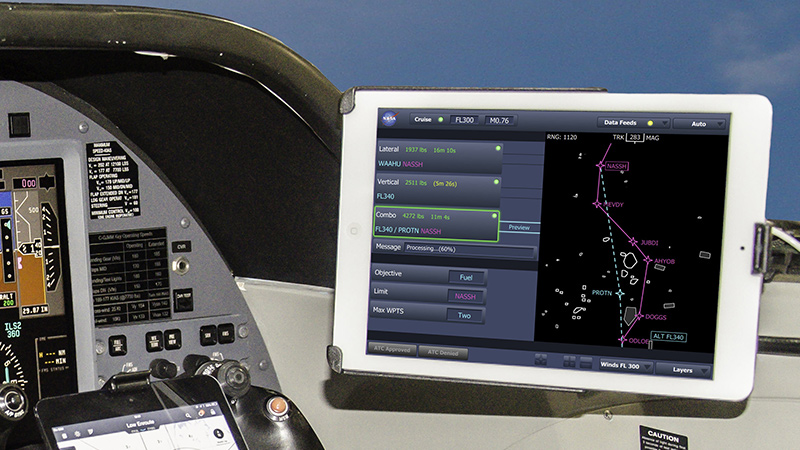Stay Up to Date
Submit your email address to receive the latest industry and Aerospace America news.
The Aircraft Operations Technical Committee promotes safe and efficient flights by encouraging communication and interchange of relevant concerns, ideas and initiatives across the stakeholder community.
The use of Electronic Flight Bag applications by pilots grew this year. Alaska Airlines began integrating NASA’s Traffic Aware Planner app on three Boeing 737-900ER jets. With TAP, a pilot can send a route optimization request to air traffic controllers to reduce flight time and save fuel as provided under NASA’s Traffic Aware Strategic Aircrew Requests concept.
NASA’s Airspace Technology Demonstrations project continued to develop and demonstrate advanced concepts to identify promising techniques for transition to the FAA. The ATD-1 team transferred the Terminal Sequencing and Spacing software, NASA’s 2017 Software of the Year. The ATD-1 team also demonstrated a prototype of Flight-deck Interval Management avionics aboard a Boeing 787. The ATD-2 team’s Integrated Arrival/Departure/Surface Management software, which integrates these factors for metroplex environments, was scheduled to go live at Charlotte Douglas International Airport in North Carolina this year. ATD-3 finalized its air/ground integration concept, which improves efficiency and throughput for the en route and arrival phases of flight by integrating advanced ground and flight deck technologies, including the TASAR concept.
As of August, FAA Data Communications tower services, in which controllers send messages to pilots digitally, had been deployed at 55 airports. Initial en route services are expected to be deployed in 2019 and available across the National Airspace System by 2021. With Data Comm, controllers send departure clearance instructions to flight crews by text rather than by voice over radio. This speeds up the clearance process, reduces operational errors and permits more complicated messaging, such as changes to optimize operations over an entire flight route.
Also this year, Aireon, a joint venture of Iridium and four air navigation providers, began validating its collecting of space-based Automatic Dependent Surveillance-Broadcast messages from aircraft. The Iridium NEXT satellite constellation that provides this capability reached 20 satellites in orbit in June, following the launch of the first 10 satellites in January. Another 55 satellites are scheduled to be launched to enable a fully operational system by mid-2018. This technology has the potential to revolutionize air traffic control services by providing worldwide surveillance of commercial aircraft and helping identify inefficiencies and associated mitigations for improved aircraft operations on a global scale.
To improve air traffic management in the National Airspace System, NASA this year began transferring to FAA and MITRE Corp. the clear-weather portion of the Integrated Demand Management concept. IDM integrates NextGen’s strategic Traffic Flow Management System and the more tactical Time-Based Flow Management system. Integrating these software tools creates a gate-to-gate framework so that traffic managers can more readily identify when demand exceeds forecasted capacity and find a resolution. Researchers are now focused on expanding the concept for convective weather operations to reduce delays, improve throughput and facilitate user-preferred trajectories.
Over the course of four weeks in May and June, the NASA-led Unmanned Aircraft System Traffic Management team conducted its second National Campaign flight test involving collaboration with industry, and including multiple vehicles and concepts at six FAA UAS test sites. Researchers made great progress this year toward safely enabling UAS operations in low altitude (below 400 feet) airspace. NASA, FAA, other federal agencies and industry are exploring UTM concepts, data exchange requirements and a supporting framework to enable multiple beyond visual line-of-sight UAS operations in airspace where FAA air traffic services are not provided.
The FAA this year continued operational evaluation, flight test and refinement of the Airborne Collision Avoidance System Xa software for conventionally piloted aircraft and ACAS Xu for unmanned aircraft. Also, the Standard Terminal Automation Replacement System reached a milestone with its introduction in 70 terminal radar approach control facilities, including the “Big 11” that control 80 percent of the arriving and departing traffic at U.S. airports. By 2019, STARS will be operational at more than 150 civil and more than 80 military TRACONs.
Contributors: Tamsyn E. Edwards, Gabriele Enea, Antony D. Evans, Rania Ghatas, Michiel J. Schuurman
Related Posts
Stay Up to Date
Submit your email address to receive the latest industry and Aerospace America news.




